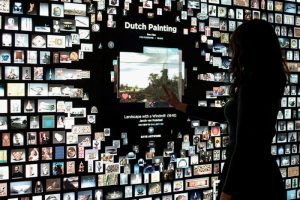 The Art Museum in the Digital Age
The Art Museum in the Digital Age
Wien, Österreichische Galerie Belvedere, 10. – 11.01.2019
Deadline: Jul 31, 2018
The foundation of innovative, future-oriented museum work is a continuous reflection of its institutional conditions and the questioning of the role of museums in the 21st century. This interdisciplinary symposium is devoted to an art-historical and media-theoretical debate on the systemic changes in the art museum type caused by the universal presence of the digital: Equally at stake are questions of institutional as well as public- and object-related variables.
Traditional core areas of a museum’s mission such as collecting, preserving, researching, educating, and exhibiting are increasingly permeated by digital expansions. Media transformations are promising the opening of museum walls and the barrier-free exchange with an increasingly diverse audience. The latter’s individual as well as collective experience of an art museum is also subject to fundamental alterations and adaptations.
Digital tools, techniques, and methods have become indispensable in a museum’s daily routine. Under the topos of the actuality of the digital, our two-day event gathers contributions which, taking into account the historical genesis of art museums, reflect mainly – but not exclusively – on the following topics and questions:
Institution & Strategy
How does the digitization of cultural assets change the historically acquired identities of museums? Will they adopt additional functions beyond their traditional core areas? What importance is attached to the digital strategies of cultural heritage institutions? And, are these strategies primarily aimed at commercial success? Furthermore, the question of the social role of the museum as an agent in the field of cultural policy arises: What effects of digitization are to be expected on the museum as an educational institution? Can it preserve its own critical stance or will it lose its authority? Which position should it represent and who determines it?
Communication & Public
What are the consequences of changing cultural techniques to established curatorial practices? Can we already notice repercussions of the digital to analog methods of work, research or display? Does the curator still act as a solitary or authoritarian body when new forms of mediatization create a new type of visitor (such as the visitor-curator) or, provocatively speaking, are we witnessing the « death of the curator »?
Subsequently, possible changes in exhibition design and art education in the sense of interactive visitor engagement are to be examined more closely. Do digital tools and the inclusion of social media alter the behavior of museum audiences? And in what ways should changing audience expectations influence physical and digital offers of art museums?
Especially for the young museum visitor, media spaces and digital offers prove to be highly relevant. In order to increasingly address and attract this target group, it seems necessary to meet their clear demand for enhanced possibilities of participation (as consumer and producer). In this respect, one has to ask: Can young people be reached exclusively via digital channels? Does their engagement with the artwork take the form of media entertainment and digital spectacle instead of silent contemplation and cultural education? Are there intergenerational concepts of communication? How do art museums face the challenge of a digitally dominated and overstimulated society?
Object & Space
Against the background of the great digitization waves of museum collections and open content policies: Do we need to re-examine well-established museological questions about the definition and significance of the exhibit as an authentic and original object? What about its relation to the beholder in the real and digital space?
Along with this issue emerges the question of lines of development with the intention of extending the museum space, from the opening of vaults through digitization measures to the virtual museum in the www or the expansion of sensory perception through the fusion of virtual and real-world offers (virtual / augmented reality).
What happens to the grand narratives? If it is true that the spatial sequences of baroque palaces determined the chronological narrative of modernism (Rosalind Krauss), what happens in the digital age, for which the database was defined as symbolic form (Lev Manovich)?
We look forward to your paper proposals in the fields of museum practice / museology, art and cultural history, media studies and digital humanities. Please submit your abstracts for a 20-25 minutes presentation in German or English (250 words maximum), including short biography and full contact information, by July 31, 2018 to: j.aufreiter@belvedere.at
Prof. Dr. Hubertus Kohle (Chair, Medieval and Early Modern Art History, LMU Munich) accepted our invitation as keynote speaker.
Conference Committee: Johanna Aufreiter, Christian Huemer, Ralph Knickmeier, Florian Waitzbauer (Österreichische Galerie Belvedere), Johanna Drucker (UCLA), Hubertus Kohle (LMU Munich)
Travel and accommodation costs can be reimbursed to a limited extent for speakers. Conference participation is free of charge.

Leave a Reply
You must be logged in to post a comment.